The Importance of Cryopreservation in Single Embryo Transfer Programs
VerifiedAdded on 2021/02/20
|12
|4408
|133
Report
AI Summary
This report focuses on the critical role of successful cryopreservation programs within the context of single embryo transfer (eSET) in assisted reproductive technology (ART). It provides an overview of the advantages of eSET in minimizing multiple pregnancies, along with the techniques and importance of embryo cryopreservation. The report highlights the differences between elective single embryo transfer (eSET) and non-elective single embryo transfer (SET), emphasizing how cryopreservation enhances the success rates of ART, especially in IVF and ICSI procedures. It discusses the cryopreservation process, including vitrification and slow freezing methods, and its impact on increasing pregnancy chances while reducing the risks associated with multiple gestations. The document underscores the importance of eSET for individuals, particularly younger women with good quality embryos, as a cost-effective and less stressful approach to fertility treatment, offering additional chances of pregnancy and addressing future fertility issues.
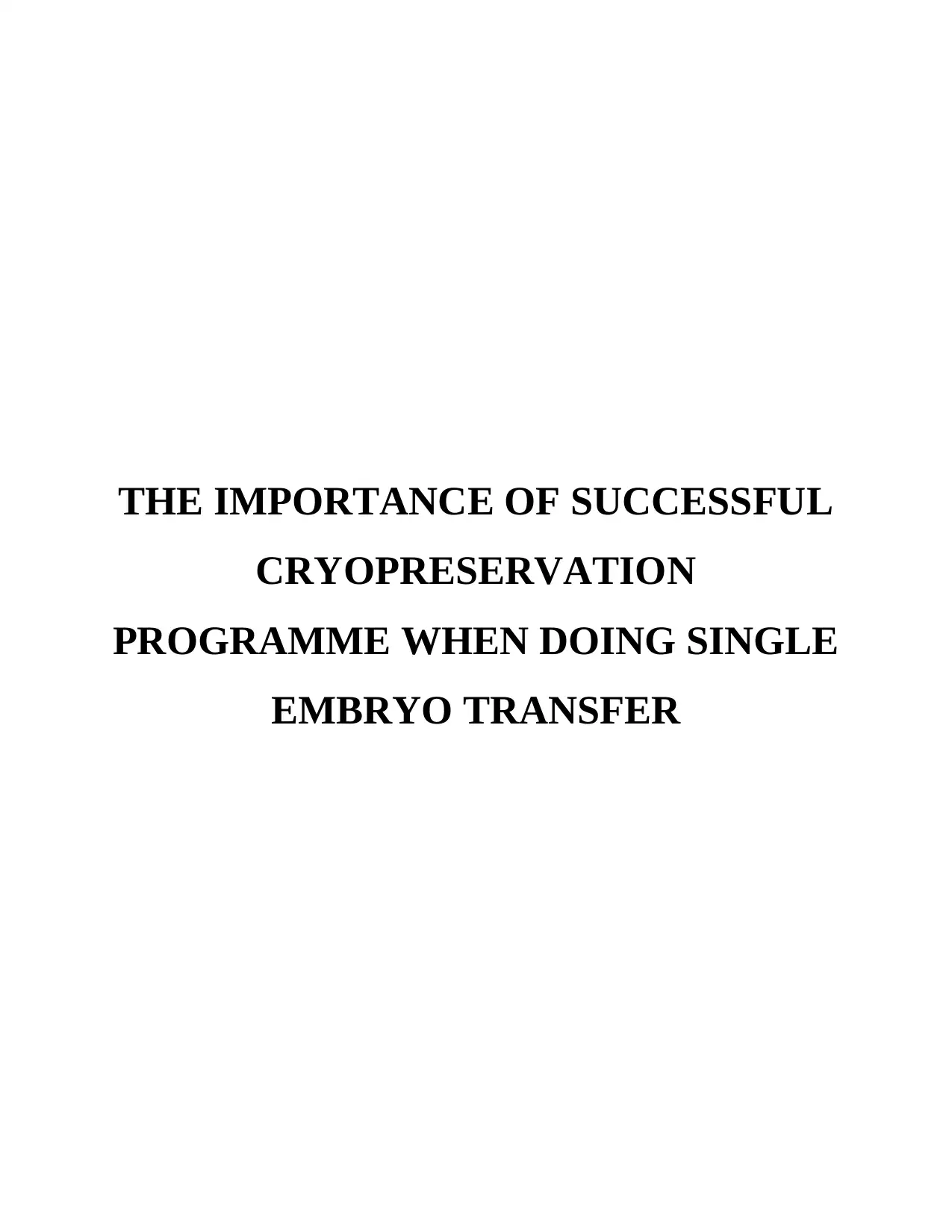
THE IMPORTANCE OF SUCCESSFUL
CRYOPRESERVATION
PROGRAMME WHEN DOING SINGLE
EMBRYO TRANSFER
CRYOPRESERVATION
PROGRAMME WHEN DOING SINGLE
EMBRYO TRANSFER
Paraphrase This Document
Need a fresh take? Get an instant paraphrase of this document with our AI Paraphraser
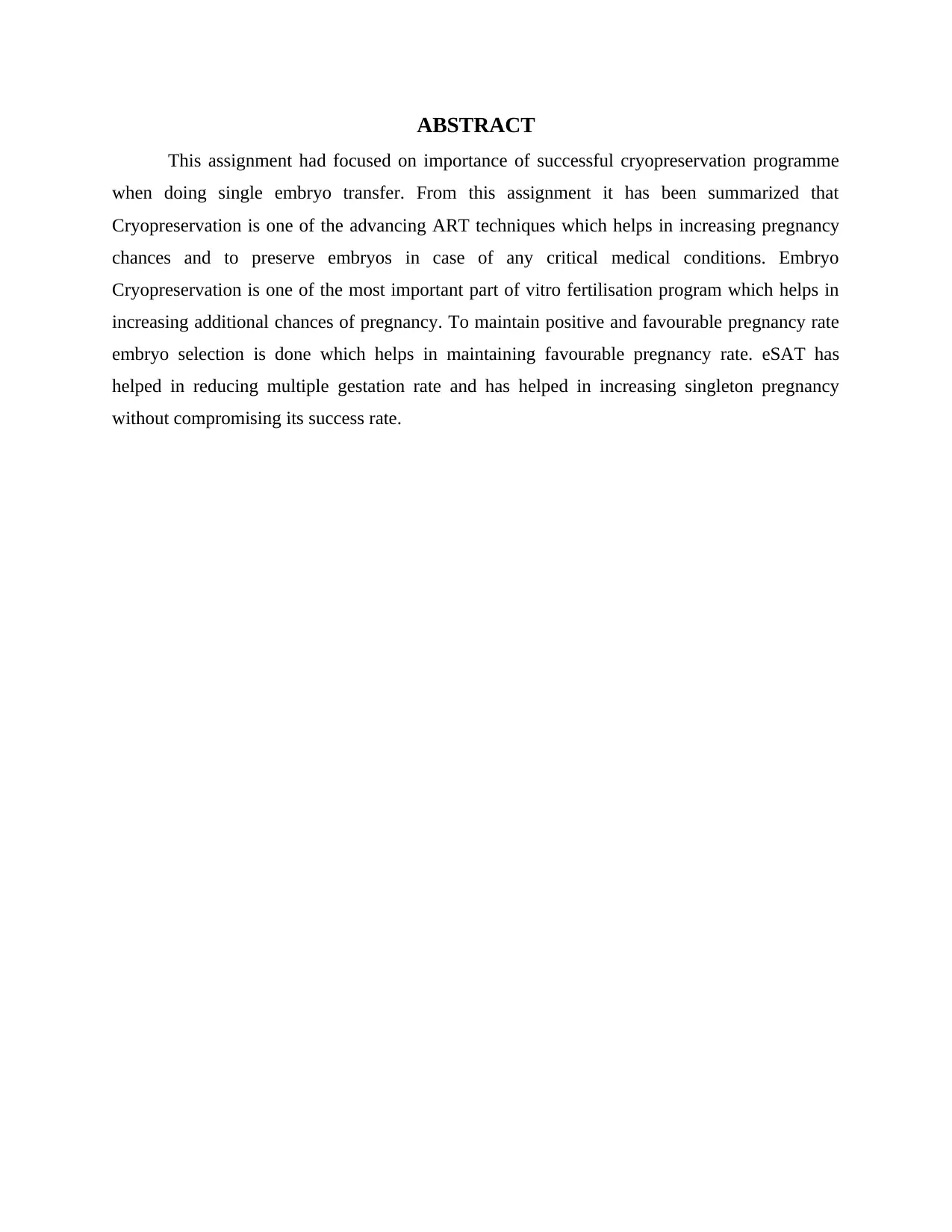
ABSTRACT
This assignment had focused on importance of successful cryopreservation programme
when doing single embryo transfer. From this assignment it has been summarized that
Cryopreservation is one of the advancing ART techniques which helps in increasing pregnancy
chances and to preserve embryos in case of any critical medical conditions. Embryo
Cryopreservation is one of the most important part of vitro fertilisation program which helps in
increasing additional chances of pregnancy. To maintain positive and favourable pregnancy rate
embryo selection is done which helps in maintaining favourable pregnancy rate. eSAT has
helped in reducing multiple gestation rate and has helped in increasing singleton pregnancy
without compromising its success rate.
This assignment had focused on importance of successful cryopreservation programme
when doing single embryo transfer. From this assignment it has been summarized that
Cryopreservation is one of the advancing ART techniques which helps in increasing pregnancy
chances and to preserve embryos in case of any critical medical conditions. Embryo
Cryopreservation is one of the most important part of vitro fertilisation program which helps in
increasing additional chances of pregnancy. To maintain positive and favourable pregnancy rate
embryo selection is done which helps in maintaining favourable pregnancy rate. eSAT has
helped in reducing multiple gestation rate and has helped in increasing singleton pregnancy
without compromising its success rate.
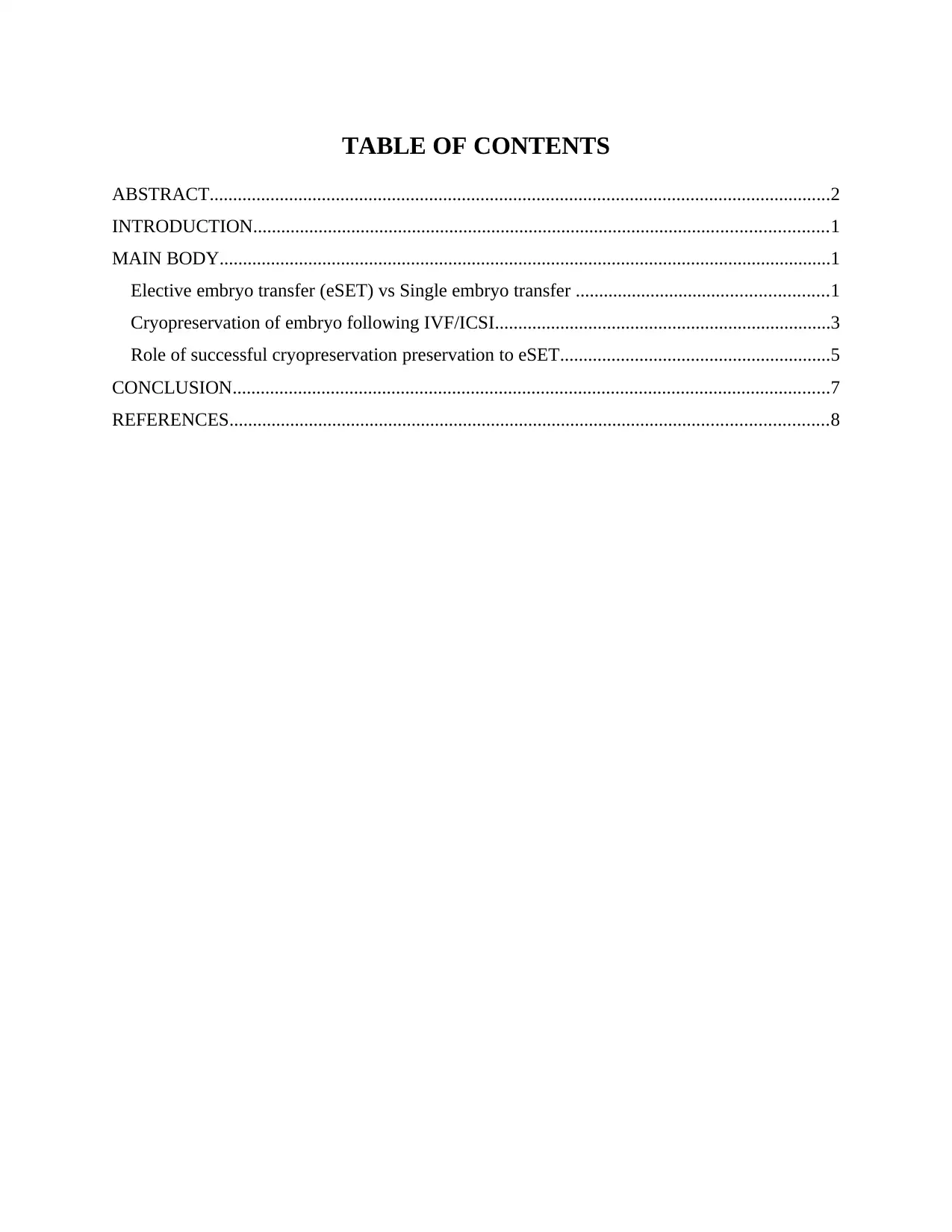
TABLE OF CONTENTS
ABSTRACT.....................................................................................................................................2
INTRODUCTION...........................................................................................................................1
MAIN BODY...................................................................................................................................1
Elective embryo transfer (eSET) vs Single embryo transfer ......................................................1
Cryopreservation of embryo following IVF/ICSI........................................................................3
Role of successful cryopreservation preservation to eSET..........................................................5
CONCLUSION................................................................................................................................7
REFERENCES................................................................................................................................8
ABSTRACT.....................................................................................................................................2
INTRODUCTION...........................................................................................................................1
MAIN BODY...................................................................................................................................1
Elective embryo transfer (eSET) vs Single embryo transfer ......................................................1
Cryopreservation of embryo following IVF/ICSI........................................................................3
Role of successful cryopreservation preservation to eSET..........................................................5
CONCLUSION................................................................................................................................7
REFERENCES................................................................................................................................8
⊘ This is a preview!⊘
Do you want full access?
Subscribe today to unlock all pages.

Trusted by 1+ million students worldwide
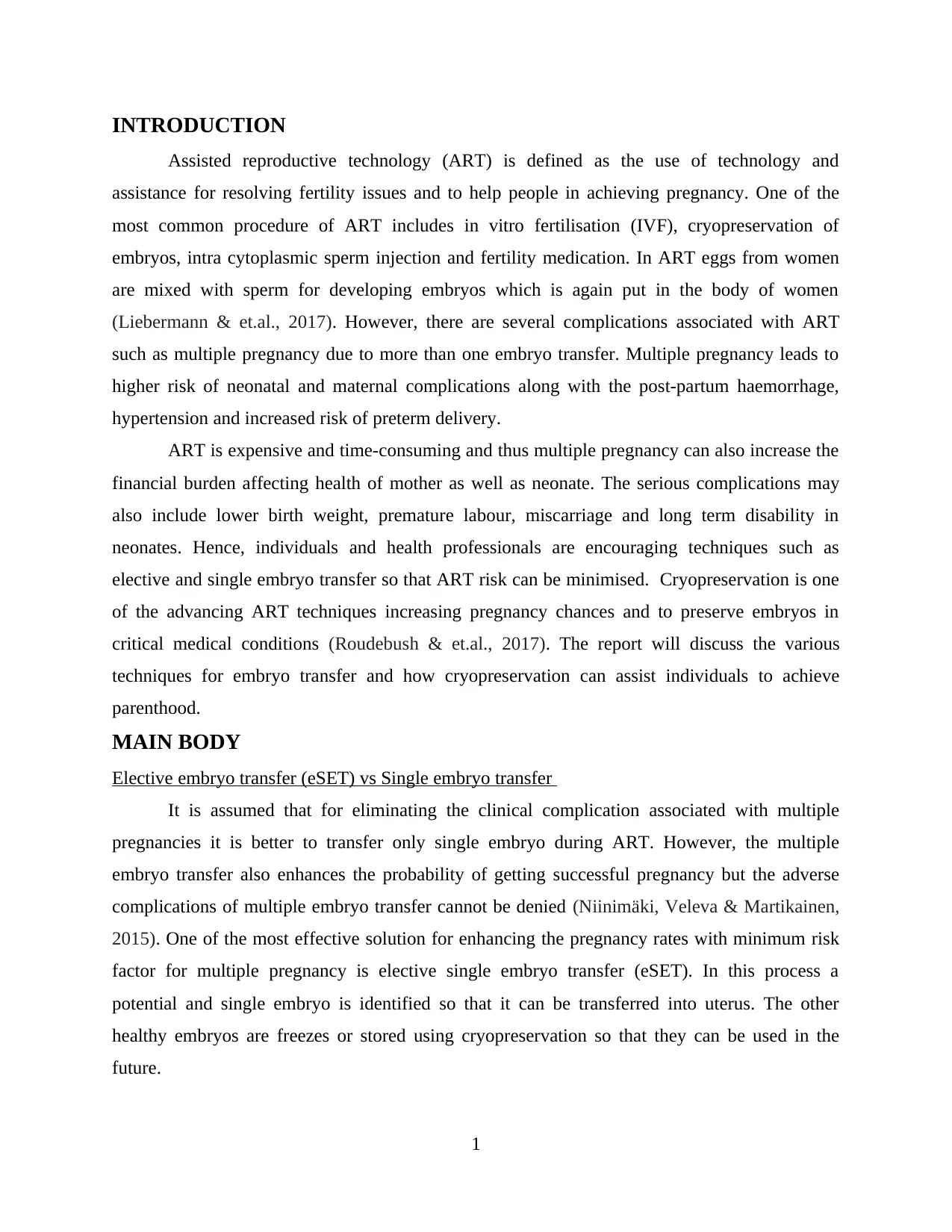
INTRODUCTION
Assisted reproductive technology (ART) is defined as the use of technology and
assistance for resolving fertility issues and to help people in achieving pregnancy. One of the
most common procedure of ART includes in vitro fertilisation (IVF), cryopreservation of
embryos, intra cytoplasmic sperm injection and fertility medication. In ART eggs from women
are mixed with sperm for developing embryos which is again put in the body of women
(Liebermann & et.al., 2017). However, there are several complications associated with ART
such as multiple pregnancy due to more than one embryo transfer. Multiple pregnancy leads to
higher risk of neonatal and maternal complications along with the post-partum haemorrhage,
hypertension and increased risk of preterm delivery.
ART is expensive and time-consuming and thus multiple pregnancy can also increase the
financial burden affecting health of mother as well as neonate. The serious complications may
also include lower birth weight, premature labour, miscarriage and long term disability in
neonates. Hence, individuals and health professionals are encouraging techniques such as
elective and single embryo transfer so that ART risk can be minimised. Cryopreservation is one
of the advancing ART techniques increasing pregnancy chances and to preserve embryos in
critical medical conditions (Roudebush & et.al., 2017). The report will discuss the various
techniques for embryo transfer and how cryopreservation can assist individuals to achieve
parenthood.
MAIN BODY
Elective embryo transfer (eSET) vs Single embryo transfer
It is assumed that for eliminating the clinical complication associated with multiple
pregnancies it is better to transfer only single embryo during ART. However, the multiple
embryo transfer also enhances the probability of getting successful pregnancy but the adverse
complications of multiple embryo transfer cannot be denied (Niinimäki, Veleva & Martikainen,
2015). One of the most effective solution for enhancing the pregnancy rates with minimum risk
factor for multiple pregnancy is elective single embryo transfer (eSET). In this process a
potential and single embryo is identified so that it can be transferred into uterus. The other
healthy embryos are freezes or stored using cryopreservation so that they can be used in the
future.
1
Assisted reproductive technology (ART) is defined as the use of technology and
assistance for resolving fertility issues and to help people in achieving pregnancy. One of the
most common procedure of ART includes in vitro fertilisation (IVF), cryopreservation of
embryos, intra cytoplasmic sperm injection and fertility medication. In ART eggs from women
are mixed with sperm for developing embryos which is again put in the body of women
(Liebermann & et.al., 2017). However, there are several complications associated with ART
such as multiple pregnancy due to more than one embryo transfer. Multiple pregnancy leads to
higher risk of neonatal and maternal complications along with the post-partum haemorrhage,
hypertension and increased risk of preterm delivery.
ART is expensive and time-consuming and thus multiple pregnancy can also increase the
financial burden affecting health of mother as well as neonate. The serious complications may
also include lower birth weight, premature labour, miscarriage and long term disability in
neonates. Hence, individuals and health professionals are encouraging techniques such as
elective and single embryo transfer so that ART risk can be minimised. Cryopreservation is one
of the advancing ART techniques increasing pregnancy chances and to preserve embryos in
critical medical conditions (Roudebush & et.al., 2017). The report will discuss the various
techniques for embryo transfer and how cryopreservation can assist individuals to achieve
parenthood.
MAIN BODY
Elective embryo transfer (eSET) vs Single embryo transfer
It is assumed that for eliminating the clinical complication associated with multiple
pregnancies it is better to transfer only single embryo during ART. However, the multiple
embryo transfer also enhances the probability of getting successful pregnancy but the adverse
complications of multiple embryo transfer cannot be denied (Niinimäki, Veleva & Martikainen,
2015). One of the most effective solution for enhancing the pregnancy rates with minimum risk
factor for multiple pregnancy is elective single embryo transfer (eSET). In this process a
potential and single embryo is identified so that it can be transferred into uterus. The other
healthy embryos are freezes or stored using cryopreservation so that they can be used in the
future.
1
Paraphrase This Document
Need a fresh take? Get an instant paraphrase of this document with our AI Paraphraser
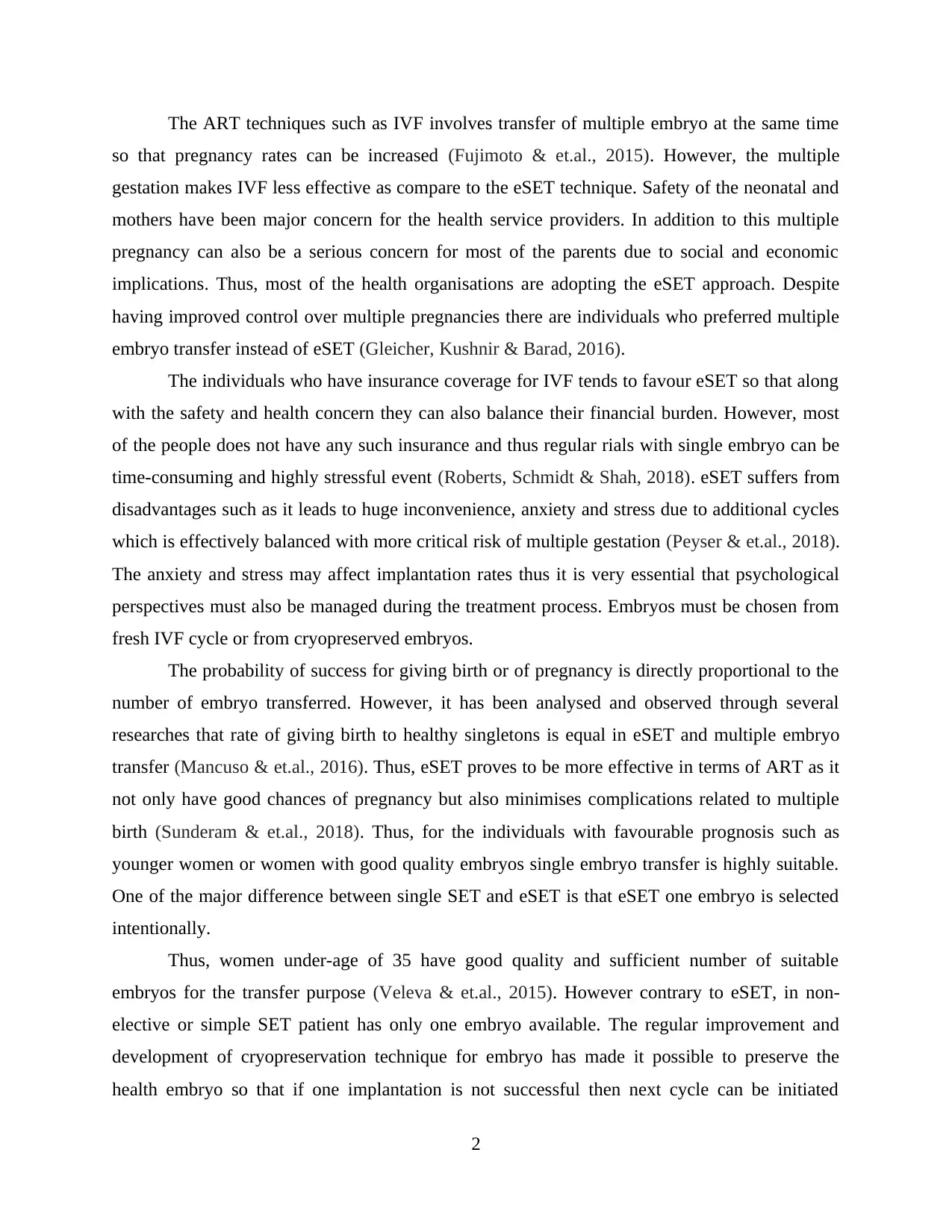
The ART techniques such as IVF involves transfer of multiple embryo at the same time
so that pregnancy rates can be increased (Fujimoto & et.al., 2015). However, the multiple
gestation makes IVF less effective as compare to the eSET technique. Safety of the neonatal and
mothers have been major concern for the health service providers. In addition to this multiple
pregnancy can also be a serious concern for most of the parents due to social and economic
implications. Thus, most of the health organisations are adopting the eSET approach. Despite
having improved control over multiple pregnancies there are individuals who preferred multiple
embryo transfer instead of eSET (Gleicher, Kushnir & Barad, 2016).
The individuals who have insurance coverage for IVF tends to favour eSET so that along
with the safety and health concern they can also balance their financial burden. However, most
of the people does not have any such insurance and thus regular rials with single embryo can be
time-consuming and highly stressful event (Roberts, Schmidt & Shah, 2018). eSET suffers from
disadvantages such as it leads to huge inconvenience, anxiety and stress due to additional cycles
which is effectively balanced with more critical risk of multiple gestation (Peyser & et.al., 2018).
The anxiety and stress may affect implantation rates thus it is very essential that psychological
perspectives must also be managed during the treatment process. Embryos must be chosen from
fresh IVF cycle or from cryopreserved embryos.
The probability of success for giving birth or of pregnancy is directly proportional to the
number of embryo transferred. However, it has been analysed and observed through several
researches that rate of giving birth to healthy singletons is equal in eSET and multiple embryo
transfer (Mancuso & et.al., 2016). Thus, eSET proves to be more effective in terms of ART as it
not only have good chances of pregnancy but also minimises complications related to multiple
birth (Sunderam & et.al., 2018). Thus, for the individuals with favourable prognosis such as
younger women or women with good quality embryos single embryo transfer is highly suitable.
One of the major difference between single SET and eSET is that eSET one embryo is selected
intentionally.
Thus, women under-age of 35 have good quality and sufficient number of suitable
embryos for the transfer purpose (Veleva & et.al., 2015). However contrary to eSET, in non-
elective or simple SET patient has only one embryo available. The regular improvement and
development of cryopreservation technique for embryo has made it possible to preserve the
health embryo so that if one implantation is not successful then next cycle can be initiated
2
so that pregnancy rates can be increased (Fujimoto & et.al., 2015). However, the multiple
gestation makes IVF less effective as compare to the eSET technique. Safety of the neonatal and
mothers have been major concern for the health service providers. In addition to this multiple
pregnancy can also be a serious concern for most of the parents due to social and economic
implications. Thus, most of the health organisations are adopting the eSET approach. Despite
having improved control over multiple pregnancies there are individuals who preferred multiple
embryo transfer instead of eSET (Gleicher, Kushnir & Barad, 2016).
The individuals who have insurance coverage for IVF tends to favour eSET so that along
with the safety and health concern they can also balance their financial burden. However, most
of the people does not have any such insurance and thus regular rials with single embryo can be
time-consuming and highly stressful event (Roberts, Schmidt & Shah, 2018). eSET suffers from
disadvantages such as it leads to huge inconvenience, anxiety and stress due to additional cycles
which is effectively balanced with more critical risk of multiple gestation (Peyser & et.al., 2018).
The anxiety and stress may affect implantation rates thus it is very essential that psychological
perspectives must also be managed during the treatment process. Embryos must be chosen from
fresh IVF cycle or from cryopreserved embryos.
The probability of success for giving birth or of pregnancy is directly proportional to the
number of embryo transferred. However, it has been analysed and observed through several
researches that rate of giving birth to healthy singletons is equal in eSET and multiple embryo
transfer (Mancuso & et.al., 2016). Thus, eSET proves to be more effective in terms of ART as it
not only have good chances of pregnancy but also minimises complications related to multiple
birth (Sunderam & et.al., 2018). Thus, for the individuals with favourable prognosis such as
younger women or women with good quality embryos single embryo transfer is highly suitable.
One of the major difference between single SET and eSET is that eSET one embryo is selected
intentionally.
Thus, women under-age of 35 have good quality and sufficient number of suitable
embryos for the transfer purpose (Veleva & et.al., 2015). However contrary to eSET, in non-
elective or simple SET patient has only one embryo available. The regular improvement and
development of cryopreservation technique for embryo has made it possible to preserve the
health embryo so that if one implantation is not successful then next cycle can be initiated
2
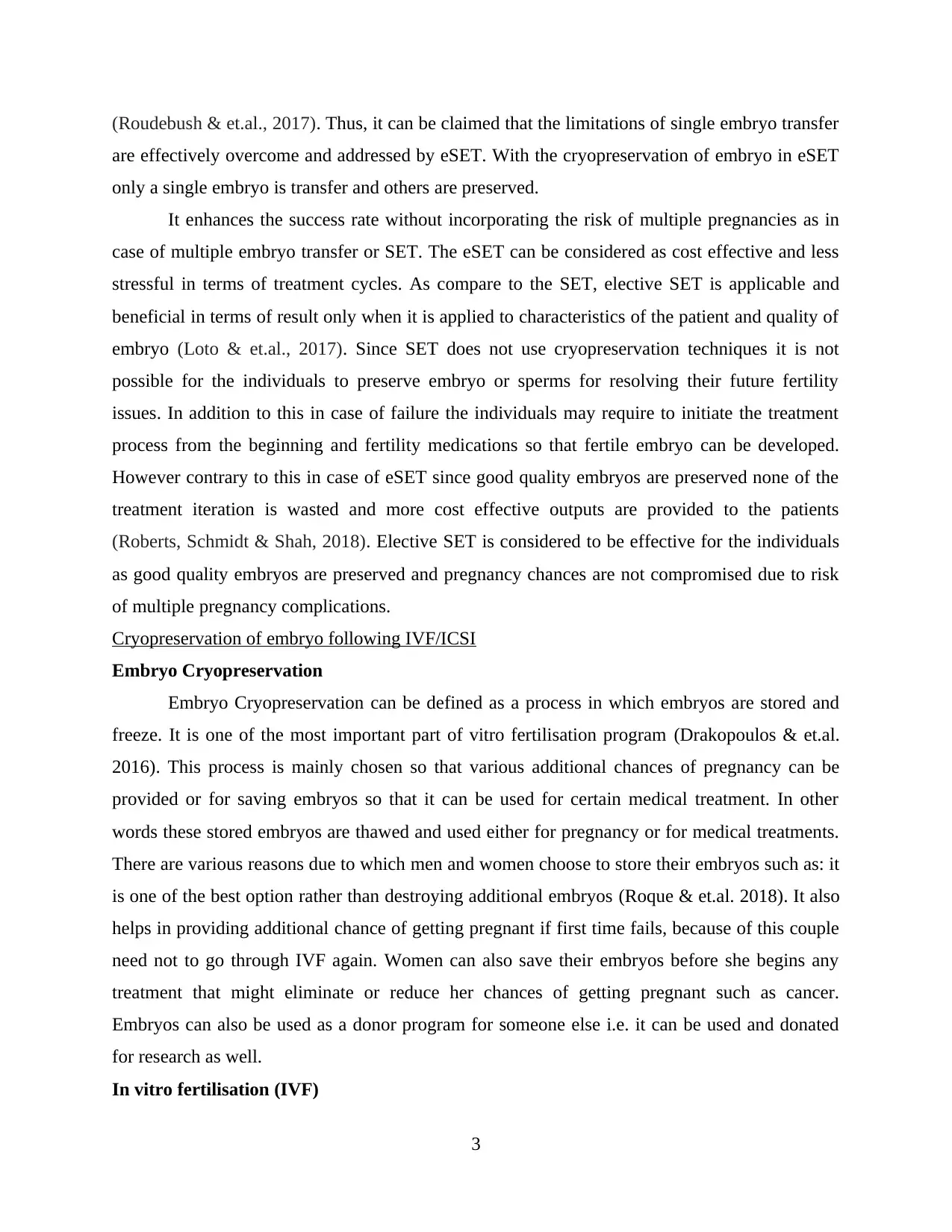
(Roudebush & et.al., 2017). Thus, it can be claimed that the limitations of single embryo transfer
are effectively overcome and addressed by eSET. With the cryopreservation of embryo in eSET
only a single embryo is transfer and others are preserved.
It enhances the success rate without incorporating the risk of multiple pregnancies as in
case of multiple embryo transfer or SET. The eSET can be considered as cost effective and less
stressful in terms of treatment cycles. As compare to the SET, elective SET is applicable and
beneficial in terms of result only when it is applied to characteristics of the patient and quality of
embryo (Loto & et.al., 2017). Since SET does not use cryopreservation techniques it is not
possible for the individuals to preserve embryo or sperms for resolving their future fertility
issues. In addition to this in case of failure the individuals may require to initiate the treatment
process from the beginning and fertility medications so that fertile embryo can be developed.
However contrary to this in case of eSET since good quality embryos are preserved none of the
treatment iteration is wasted and more cost effective outputs are provided to the patients
(Roberts, Schmidt & Shah, 2018). Elective SET is considered to be effective for the individuals
as good quality embryos are preserved and pregnancy chances are not compromised due to risk
of multiple pregnancy complications.
Cryopreservation of embryo following IVF/ICSI
Embryo Cryopreservation
Embryo Cryopreservation can be defined as a process in which embryos are stored and
freeze. It is one of the most important part of vitro fertilisation program (Drakopoulos & et.al.
2016). This process is mainly chosen so that various additional chances of pregnancy can be
provided or for saving embryos so that it can be used for certain medical treatment. In other
words these stored embryos are thawed and used either for pregnancy or for medical treatments.
There are various reasons due to which men and women choose to store their embryos such as: it
is one of the best option rather than destroying additional embryos (Roque & et.al. 2018). It also
helps in providing additional chance of getting pregnant if first time fails, because of this couple
need not to go through IVF again. Women can also save their embryos before she begins any
treatment that might eliminate or reduce her chances of getting pregnant such as cancer.
Embryos can also be used as a donor program for someone else i.e. it can be used and donated
for research as well.
In vitro fertilisation (IVF)
3
are effectively overcome and addressed by eSET. With the cryopreservation of embryo in eSET
only a single embryo is transfer and others are preserved.
It enhances the success rate without incorporating the risk of multiple pregnancies as in
case of multiple embryo transfer or SET. The eSET can be considered as cost effective and less
stressful in terms of treatment cycles. As compare to the SET, elective SET is applicable and
beneficial in terms of result only when it is applied to characteristics of the patient and quality of
embryo (Loto & et.al., 2017). Since SET does not use cryopreservation techniques it is not
possible for the individuals to preserve embryo or sperms for resolving their future fertility
issues. In addition to this in case of failure the individuals may require to initiate the treatment
process from the beginning and fertility medications so that fertile embryo can be developed.
However contrary to this in case of eSET since good quality embryos are preserved none of the
treatment iteration is wasted and more cost effective outputs are provided to the patients
(Roberts, Schmidt & Shah, 2018). Elective SET is considered to be effective for the individuals
as good quality embryos are preserved and pregnancy chances are not compromised due to risk
of multiple pregnancy complications.
Cryopreservation of embryo following IVF/ICSI
Embryo Cryopreservation
Embryo Cryopreservation can be defined as a process in which embryos are stored and
freeze. It is one of the most important part of vitro fertilisation program (Drakopoulos & et.al.
2016). This process is mainly chosen so that various additional chances of pregnancy can be
provided or for saving embryos so that it can be used for certain medical treatment. In other
words these stored embryos are thawed and used either for pregnancy or for medical treatments.
There are various reasons due to which men and women choose to store their embryos such as: it
is one of the best option rather than destroying additional embryos (Roque & et.al. 2018). It also
helps in providing additional chance of getting pregnant if first time fails, because of this couple
need not to go through IVF again. Women can also save their embryos before she begins any
treatment that might eliminate or reduce her chances of getting pregnant such as cancer.
Embryos can also be used as a donor program for someone else i.e. it can be used and donated
for research as well.
In vitro fertilisation (IVF)
3
⊘ This is a preview!⊘
Do you want full access?
Subscribe today to unlock all pages.

Trusted by 1+ million students worldwide
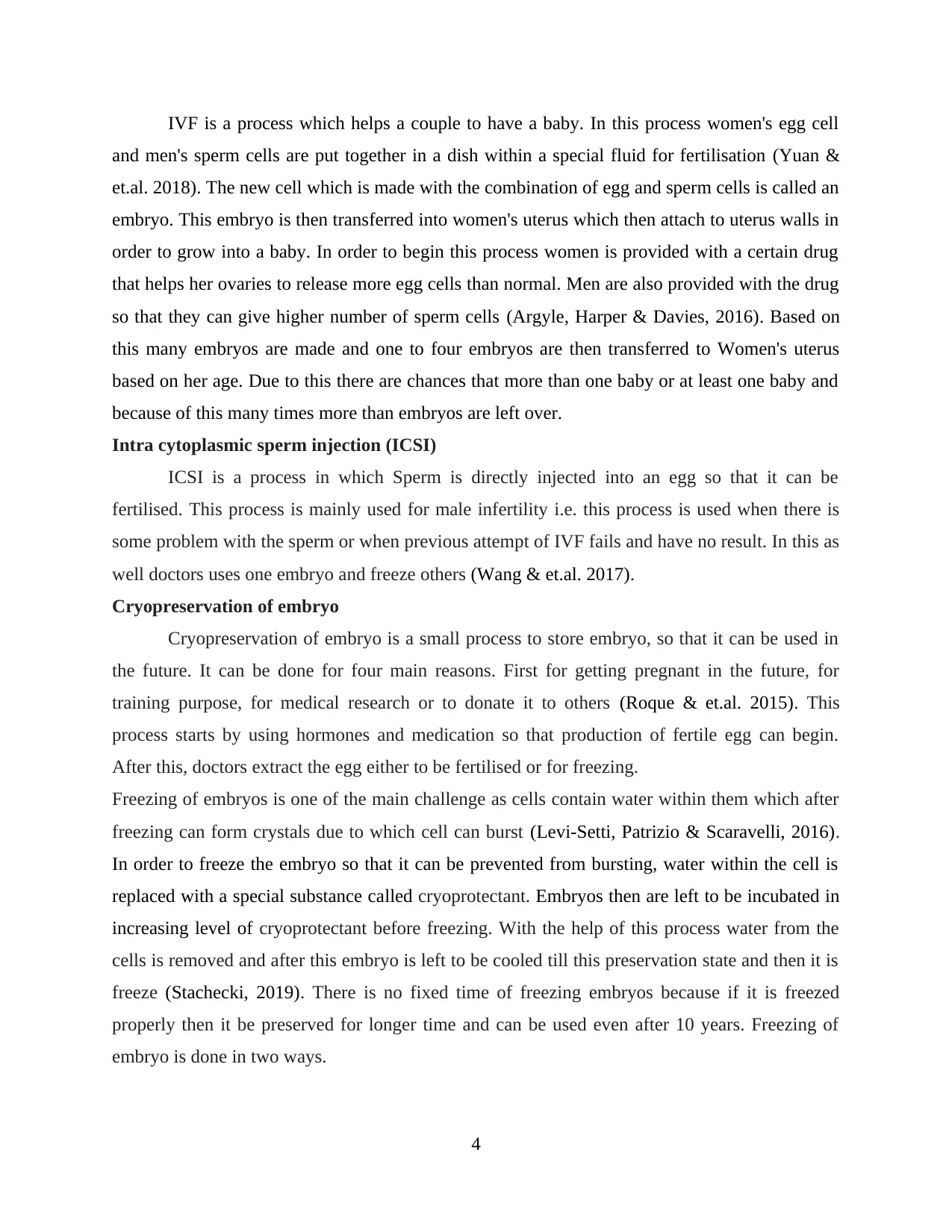
IVF is a process which helps a couple to have a baby. In this process women's egg cell
and men's sperm cells are put together in a dish within a special fluid for fertilisation (Yuan &
et.al. 2018). The new cell which is made with the combination of egg and sperm cells is called an
embryo. This embryo is then transferred into women's uterus which then attach to uterus walls in
order to grow into a baby. In order to begin this process women is provided with a certain drug
that helps her ovaries to release more egg cells than normal. Men are also provided with the drug
so that they can give higher number of sperm cells (Argyle, Harper & Davies, 2016). Based on
this many embryos are made and one to four embryos are then transferred to Women's uterus
based on her age. Due to this there are chances that more than one baby or at least one baby and
because of this many times more than embryos are left over.
Intra cytoplasmic sperm injection (ICSI)
ICSI is a process in which Sperm is directly injected into an egg so that it can be
fertilised. This process is mainly used for male infertility i.e. this process is used when there is
some problem with the sperm or when previous attempt of IVF fails and have no result. In this as
well doctors uses one embryo and freeze others (Wang & et.al. 2017).
Cryopreservation of embryo
Cryopreservation of embryo is a small process to store embryo, so that it can be used in
the future. It can be done for four main reasons. First for getting pregnant in the future, for
training purpose, for medical research or to donate it to others (Roque & et.al. 2015). This
process starts by using hormones and medication so that production of fertile egg can begin.
After this, doctors extract the egg either to be fertilised or for freezing.
Freezing of embryos is one of the main challenge as cells contain water within them which after
freezing can form crystals due to which cell can burst (Levi-Setti, Patrizio & Scaravelli, 2016).
In order to freeze the embryo so that it can be prevented from bursting, water within the cell is
replaced with a special substance called cryoprotectant. Embryos then are left to be incubated in
increasing level of cryoprotectant before freezing. With the help of this process water from the
cells is removed and after this embryo is left to be cooled till this preservation state and then it is
freeze (Stachecki, 2019). There is no fixed time of freezing embryos because if it is freezed
properly then it be preserved for longer time and can be used even after 10 years. Freezing of
embryo is done in two ways.
4
and men's sperm cells are put together in a dish within a special fluid for fertilisation (Yuan &
et.al. 2018). The new cell which is made with the combination of egg and sperm cells is called an
embryo. This embryo is then transferred into women's uterus which then attach to uterus walls in
order to grow into a baby. In order to begin this process women is provided with a certain drug
that helps her ovaries to release more egg cells than normal. Men are also provided with the drug
so that they can give higher number of sperm cells (Argyle, Harper & Davies, 2016). Based on
this many embryos are made and one to four embryos are then transferred to Women's uterus
based on her age. Due to this there are chances that more than one baby or at least one baby and
because of this many times more than embryos are left over.
Intra cytoplasmic sperm injection (ICSI)
ICSI is a process in which Sperm is directly injected into an egg so that it can be
fertilised. This process is mainly used for male infertility i.e. this process is used when there is
some problem with the sperm or when previous attempt of IVF fails and have no result. In this as
well doctors uses one embryo and freeze others (Wang & et.al. 2017).
Cryopreservation of embryo
Cryopreservation of embryo is a small process to store embryo, so that it can be used in
the future. It can be done for four main reasons. First for getting pregnant in the future, for
training purpose, for medical research or to donate it to others (Roque & et.al. 2015). This
process starts by using hormones and medication so that production of fertile egg can begin.
After this, doctors extract the egg either to be fertilised or for freezing.
Freezing of embryos is one of the main challenge as cells contain water within them which after
freezing can form crystals due to which cell can burst (Levi-Setti, Patrizio & Scaravelli, 2016).
In order to freeze the embryo so that it can be prevented from bursting, water within the cell is
replaced with a special substance called cryoprotectant. Embryos then are left to be incubated in
increasing level of cryoprotectant before freezing. With the help of this process water from the
cells is removed and after this embryo is left to be cooled till this preservation state and then it is
freeze (Stachecki, 2019). There is no fixed time of freezing embryos because if it is freezed
properly then it be preserved for longer time and can be used even after 10 years. Freezing of
embryo is done in two ways.
4
Paraphrase This Document
Need a fresh take? Get an instant paraphrase of this document with our AI Paraphraser
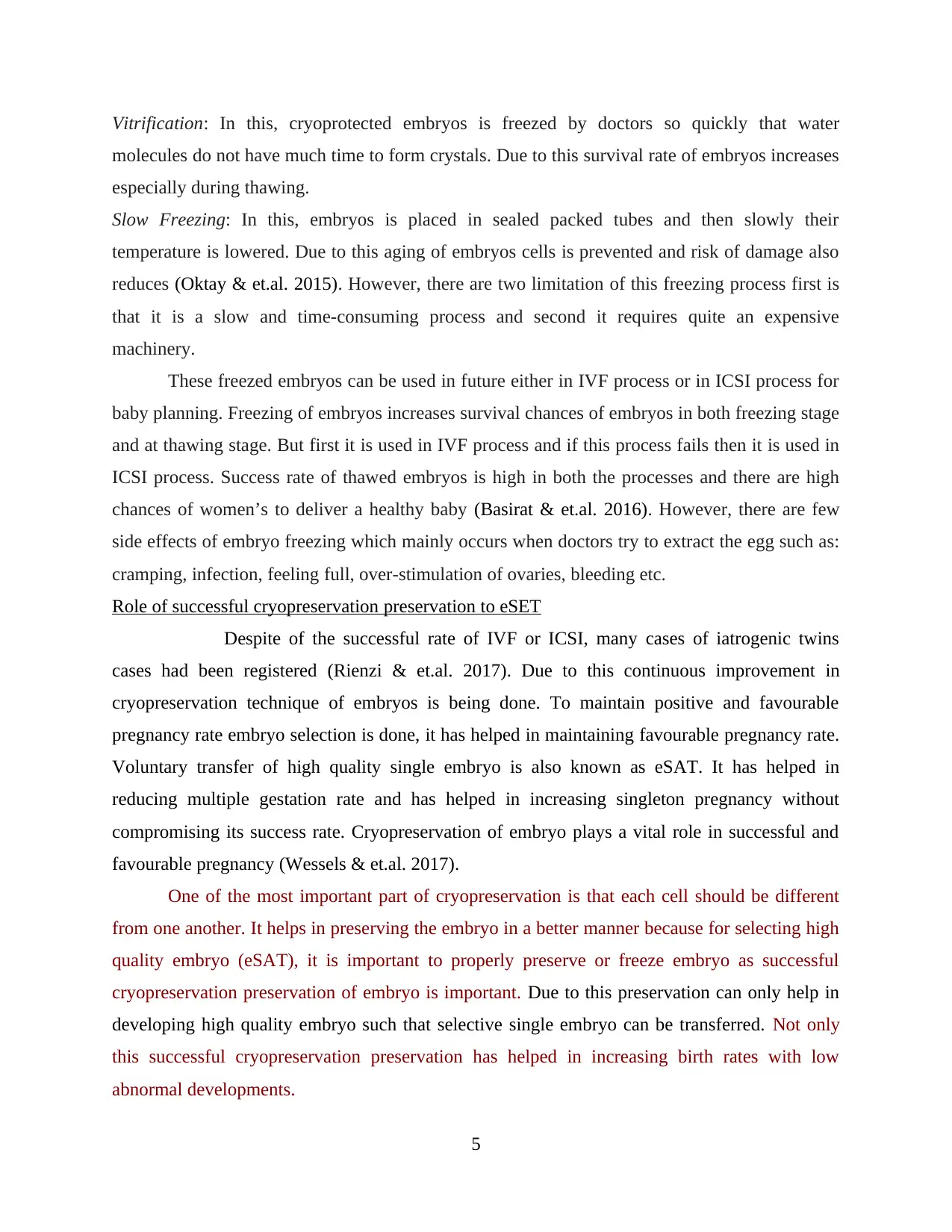
Vitrification: In this, cryoprotected embryos is freezed by doctors so quickly that water
molecules do not have much time to form crystals. Due to this survival rate of embryos increases
especially during thawing.
Slow Freezing: In this, embryos is placed in sealed packed tubes and then slowly their
temperature is lowered. Due to this aging of embryos cells is prevented and risk of damage also
reduces (Oktay & et.al. 2015). However, there are two limitation of this freezing process first is
that it is a slow and time-consuming process and second it requires quite an expensive
machinery.
These freezed embryos can be used in future either in IVF process or in ICSI process for
baby planning. Freezing of embryos increases survival chances of embryos in both freezing stage
and at thawing stage. But first it is used in IVF process and if this process fails then it is used in
ICSI process. Success rate of thawed embryos is high in both the processes and there are high
chances of women’s to deliver a healthy baby (Basirat & et.al. 2016). However, there are few
side effects of embryo freezing which mainly occurs when doctors try to extract the egg such as:
cramping, infection, feeling full, over-stimulation of ovaries, bleeding etc.
Role of successful cryopreservation preservation to eSET
Despite of the successful rate of IVF or ICSI, many cases of iatrogenic twins
cases had been registered (Rienzi & et.al. 2017). Due to this continuous improvement in
cryopreservation technique of embryos is being done. To maintain positive and favourable
pregnancy rate embryo selection is done, it has helped in maintaining favourable pregnancy rate.
Voluntary transfer of high quality single embryo is also known as eSAT. It has helped in
reducing multiple gestation rate and has helped in increasing singleton pregnancy without
compromising its success rate. Cryopreservation of embryo plays a vital role in successful and
favourable pregnancy (Wessels & et.al. 2017).
One of the most important part of cryopreservation is that each cell should be different
from one another. It helps in preserving the embryo in a better manner because for selecting high
quality embryo (eSAT), it is important to properly preserve or freeze embryo as successful
cryopreservation preservation of embryo is important. Due to this preservation can only help in
developing high quality embryo such that selective single embryo can be transferred. Not only
this successful cryopreservation preservation has helped in increasing birth rates with low
abnormal developments.
5
molecules do not have much time to form crystals. Due to this survival rate of embryos increases
especially during thawing.
Slow Freezing: In this, embryos is placed in sealed packed tubes and then slowly their
temperature is lowered. Due to this aging of embryos cells is prevented and risk of damage also
reduces (Oktay & et.al. 2015). However, there are two limitation of this freezing process first is
that it is a slow and time-consuming process and second it requires quite an expensive
machinery.
These freezed embryos can be used in future either in IVF process or in ICSI process for
baby planning. Freezing of embryos increases survival chances of embryos in both freezing stage
and at thawing stage. But first it is used in IVF process and if this process fails then it is used in
ICSI process. Success rate of thawed embryos is high in both the processes and there are high
chances of women’s to deliver a healthy baby (Basirat & et.al. 2016). However, there are few
side effects of embryo freezing which mainly occurs when doctors try to extract the egg such as:
cramping, infection, feeling full, over-stimulation of ovaries, bleeding etc.
Role of successful cryopreservation preservation to eSET
Despite of the successful rate of IVF or ICSI, many cases of iatrogenic twins
cases had been registered (Rienzi & et.al. 2017). Due to this continuous improvement in
cryopreservation technique of embryos is being done. To maintain positive and favourable
pregnancy rate embryo selection is done, it has helped in maintaining favourable pregnancy rate.
Voluntary transfer of high quality single embryo is also known as eSAT. It has helped in
reducing multiple gestation rate and has helped in increasing singleton pregnancy without
compromising its success rate. Cryopreservation of embryo plays a vital role in successful and
favourable pregnancy (Wessels & et.al. 2017).
One of the most important part of cryopreservation is that each cell should be different
from one another. It helps in preserving the embryo in a better manner because for selecting high
quality embryo (eSAT), it is important to properly preserve or freeze embryo as successful
cryopreservation preservation of embryo is important. Due to this preservation can only help in
developing high quality embryo such that selective single embryo can be transferred. Not only
this successful cryopreservation preservation has helped in increasing birth rates with low
abnormal developments.
5
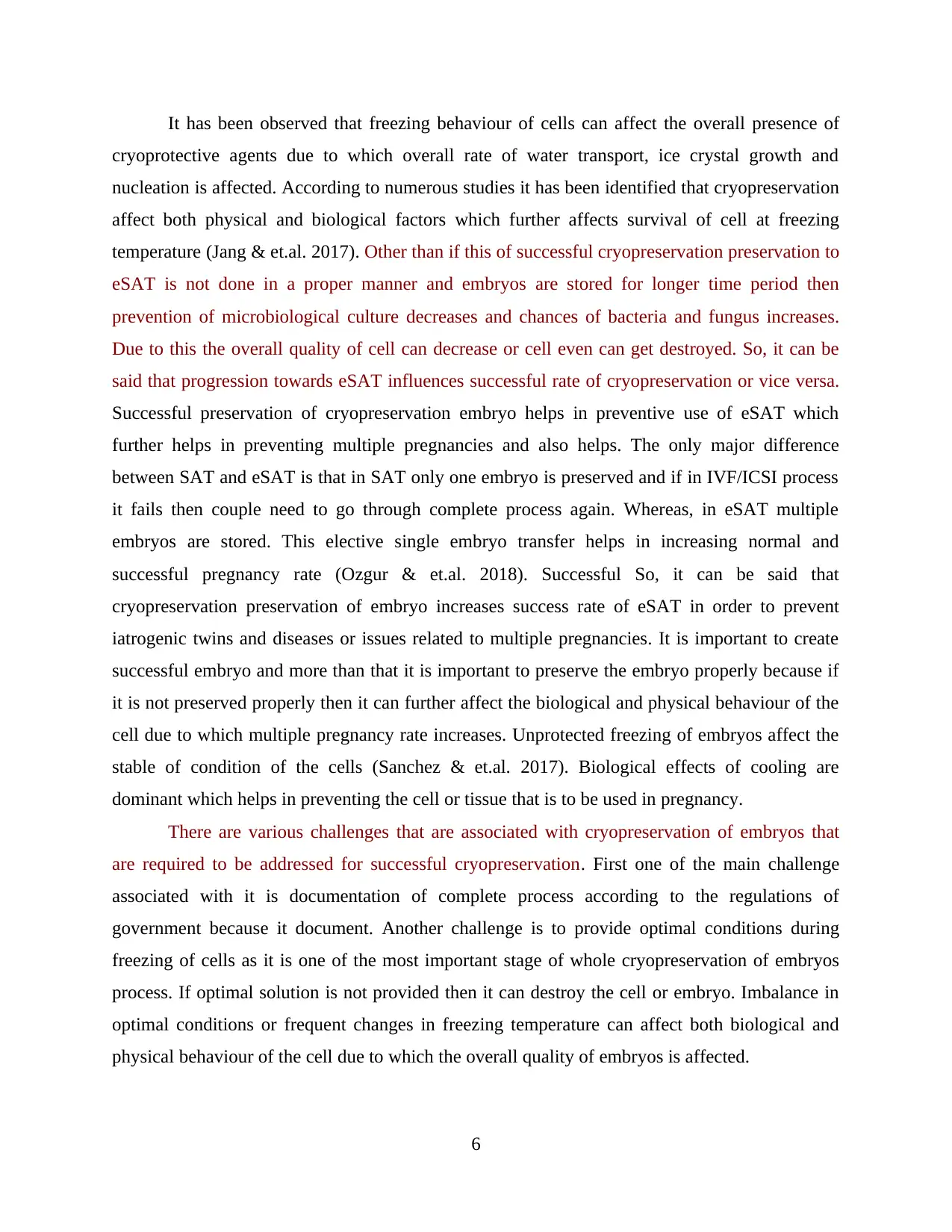
It has been observed that freezing behaviour of cells can affect the overall presence of
cryoprotective agents due to which overall rate of water transport, ice crystal growth and
nucleation is affected. According to numerous studies it has been identified that cryopreservation
affect both physical and biological factors which further affects survival of cell at freezing
temperature (Jang & et.al. 2017). Other than if this of successful cryopreservation preservation to
eSAT is not done in a proper manner and embryos are stored for longer time period then
prevention of microbiological culture decreases and chances of bacteria and fungus increases.
Due to this the overall quality of cell can decrease or cell even can get destroyed. So, it can be
said that progression towards eSAT influences successful rate of cryopreservation or vice versa.
Successful preservation of cryopreservation embryo helps in preventive use of eSAT which
further helps in preventing multiple pregnancies and also helps. The only major difference
between SAT and eSAT is that in SAT only one embryo is preserved and if in IVF/ICSI process
it fails then couple need to go through complete process again. Whereas, in eSAT multiple
embryos are stored. This elective single embryo transfer helps in increasing normal and
successful pregnancy rate (Ozgur & et.al. 2018). Successful So, it can be said that
cryopreservation preservation of embryo increases success rate of eSAT in order to prevent
iatrogenic twins and diseases or issues related to multiple pregnancies. It is important to create
successful embryo and more than that it is important to preserve the embryo properly because if
it is not preserved properly then it can further affect the biological and physical behaviour of the
cell due to which multiple pregnancy rate increases. Unprotected freezing of embryos affect the
stable of condition of the cells (Sanchez & et.al. 2017). Biological effects of cooling are
dominant which helps in preventing the cell or tissue that is to be used in pregnancy.
There are various challenges that are associated with cryopreservation of embryos that
are required to be addressed for successful cryopreservation. First one of the main challenge
associated with it is documentation of complete process according to the regulations of
government because it document. Another challenge is to provide optimal conditions during
freezing of cells as it is one of the most important stage of whole cryopreservation of embryos
process. If optimal solution is not provided then it can destroy the cell or embryo. Imbalance in
optimal conditions or frequent changes in freezing temperature can affect both biological and
physical behaviour of the cell due to which the overall quality of embryos is affected.
6
cryoprotective agents due to which overall rate of water transport, ice crystal growth and
nucleation is affected. According to numerous studies it has been identified that cryopreservation
affect both physical and biological factors which further affects survival of cell at freezing
temperature (Jang & et.al. 2017). Other than if this of successful cryopreservation preservation to
eSAT is not done in a proper manner and embryos are stored for longer time period then
prevention of microbiological culture decreases and chances of bacteria and fungus increases.
Due to this the overall quality of cell can decrease or cell even can get destroyed. So, it can be
said that progression towards eSAT influences successful rate of cryopreservation or vice versa.
Successful preservation of cryopreservation embryo helps in preventive use of eSAT which
further helps in preventing multiple pregnancies and also helps. The only major difference
between SAT and eSAT is that in SAT only one embryo is preserved and if in IVF/ICSI process
it fails then couple need to go through complete process again. Whereas, in eSAT multiple
embryos are stored. This elective single embryo transfer helps in increasing normal and
successful pregnancy rate (Ozgur & et.al. 2018). Successful So, it can be said that
cryopreservation preservation of embryo increases success rate of eSAT in order to prevent
iatrogenic twins and diseases or issues related to multiple pregnancies. It is important to create
successful embryo and more than that it is important to preserve the embryo properly because if
it is not preserved properly then it can further affect the biological and physical behaviour of the
cell due to which multiple pregnancy rate increases. Unprotected freezing of embryos affect the
stable of condition of the cells (Sanchez & et.al. 2017). Biological effects of cooling are
dominant which helps in preventing the cell or tissue that is to be used in pregnancy.
There are various challenges that are associated with cryopreservation of embryos that
are required to be addressed for successful cryopreservation. First one of the main challenge
associated with it is documentation of complete process according to the regulations of
government because it document. Another challenge is to provide optimal conditions during
freezing of cells as it is one of the most important stage of whole cryopreservation of embryos
process. If optimal solution is not provided then it can destroy the cell or embryo. Imbalance in
optimal conditions or frequent changes in freezing temperature can affect both biological and
physical behaviour of the cell due to which the overall quality of embryos is affected.
6
⊘ This is a preview!⊘
Do you want full access?
Subscribe today to unlock all pages.

Trusted by 1+ million students worldwide
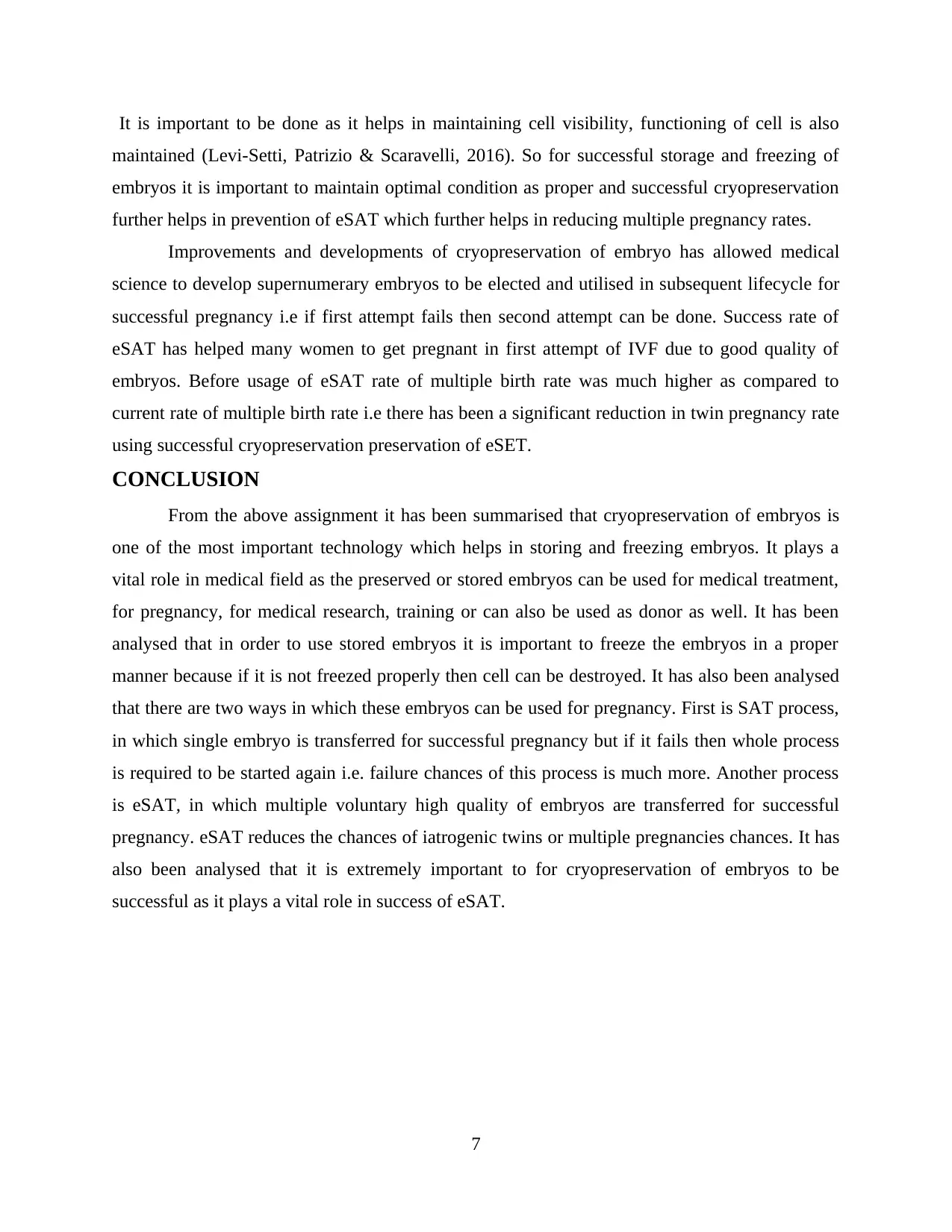
It is important to be done as it helps in maintaining cell visibility, functioning of cell is also
maintained (Levi-Setti, Patrizio & Scaravelli, 2016). So for successful storage and freezing of
embryos it is important to maintain optimal condition as proper and successful cryopreservation
further helps in prevention of eSAT which further helps in reducing multiple pregnancy rates.
Improvements and developments of cryopreservation of embryo has allowed medical
science to develop supernumerary embryos to be elected and utilised in subsequent lifecycle for
successful pregnancy i.e if first attempt fails then second attempt can be done. Success rate of
eSAT has helped many women to get pregnant in first attempt of IVF due to good quality of
embryos. Before usage of eSAT rate of multiple birth rate was much higher as compared to
current rate of multiple birth rate i.e there has been a significant reduction in twin pregnancy rate
using successful cryopreservation preservation of eSET.
CONCLUSION
From the above assignment it has been summarised that cryopreservation of embryos is
one of the most important technology which helps in storing and freezing embryos. It plays a
vital role in medical field as the preserved or stored embryos can be used for medical treatment,
for pregnancy, for medical research, training or can also be used as donor as well. It has been
analysed that in order to use stored embryos it is important to freeze the embryos in a proper
manner because if it is not freezed properly then cell can be destroyed. It has also been analysed
that there are two ways in which these embryos can be used for pregnancy. First is SAT process,
in which single embryo is transferred for successful pregnancy but if it fails then whole process
is required to be started again i.e. failure chances of this process is much more. Another process
is eSAT, in which multiple voluntary high quality of embryos are transferred for successful
pregnancy. eSAT reduces the chances of iatrogenic twins or multiple pregnancies chances. It has
also been analysed that it is extremely important to for cryopreservation of embryos to be
successful as it plays a vital role in success of eSAT.
7
maintained (Levi-Setti, Patrizio & Scaravelli, 2016). So for successful storage and freezing of
embryos it is important to maintain optimal condition as proper and successful cryopreservation
further helps in prevention of eSAT which further helps in reducing multiple pregnancy rates.
Improvements and developments of cryopreservation of embryo has allowed medical
science to develop supernumerary embryos to be elected and utilised in subsequent lifecycle for
successful pregnancy i.e if first attempt fails then second attempt can be done. Success rate of
eSAT has helped many women to get pregnant in first attempt of IVF due to good quality of
embryos. Before usage of eSAT rate of multiple birth rate was much higher as compared to
current rate of multiple birth rate i.e there has been a significant reduction in twin pregnancy rate
using successful cryopreservation preservation of eSET.
CONCLUSION
From the above assignment it has been summarised that cryopreservation of embryos is
one of the most important technology which helps in storing and freezing embryos. It plays a
vital role in medical field as the preserved or stored embryos can be used for medical treatment,
for pregnancy, for medical research, training or can also be used as donor as well. It has been
analysed that in order to use stored embryos it is important to freeze the embryos in a proper
manner because if it is not freezed properly then cell can be destroyed. It has also been analysed
that there are two ways in which these embryos can be used for pregnancy. First is SAT process,
in which single embryo is transferred for successful pregnancy but if it fails then whole process
is required to be started again i.e. failure chances of this process is much more. Another process
is eSAT, in which multiple voluntary high quality of embryos are transferred for successful
pregnancy. eSAT reduces the chances of iatrogenic twins or multiple pregnancies chances. It has
also been analysed that it is extremely important to for cryopreservation of embryos to be
successful as it plays a vital role in success of eSAT.
7
Paraphrase This Document
Need a fresh take? Get an instant paraphrase of this document with our AI Paraphraser
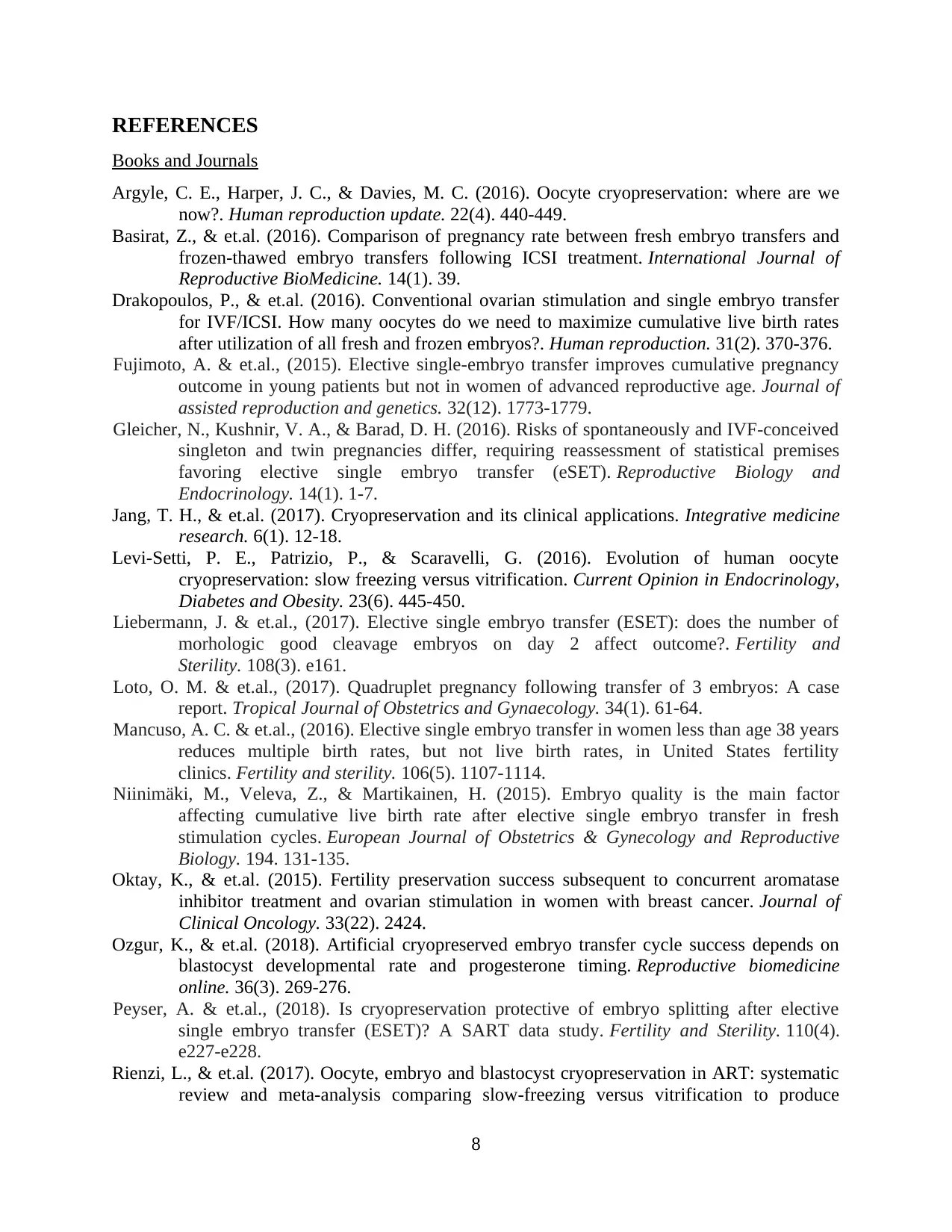
REFERENCES
Books and Journals
Argyle, C. E., Harper, J. C., & Davies, M. C. (2016). Oocyte cryopreservation: where are we
now?. Human reproduction update. 22(4). 440-449.
Basirat, Z., & et.al. (2016). Comparison of pregnancy rate between fresh embryo transfers and
frozen-thawed embryo transfers following ICSI treatment. International Journal of
Reproductive BioMedicine. 14(1). 39.
Drakopoulos, P., & et.al. (2016). Conventional ovarian stimulation and single embryo transfer
for IVF/ICSI. How many oocytes do we need to maximize cumulative live birth rates
after utilization of all fresh and frozen embryos?. Human reproduction. 31(2). 370-376.
Fujimoto, A. & et.al., (2015). Elective single-embryo transfer improves cumulative pregnancy
outcome in young patients but not in women of advanced reproductive age. Journal of
assisted reproduction and genetics. 32(12). 1773-1779.
Gleicher, N., Kushnir, V. A., & Barad, D. H. (2016). Risks of spontaneously and IVF-conceived
singleton and twin pregnancies differ, requiring reassessment of statistical premises
favoring elective single embryo transfer (eSET). Reproductive Biology and
Endocrinology. 14(1). 1-7.
Jang, T. H., & et.al. (2017). Cryopreservation and its clinical applications. Integrative medicine
research. 6(1). 12-18.
Levi-Setti, P. E., Patrizio, P., & Scaravelli, G. (2016). Evolution of human oocyte
cryopreservation: slow freezing versus vitrification. Current Opinion in Endocrinology,
Diabetes and Obesity. 23(6). 445-450.
Liebermann, J. & et.al., (2017). Elective single embryo transfer (ESET): does the number of
morhologic good cleavage embryos on day 2 affect outcome?. Fertility and
Sterility. 108(3). e161.
Loto, O. M. & et.al., (2017). Quadruplet pregnancy following transfer of 3 embryos: A case
report. Tropical Journal of Obstetrics and Gynaecology. 34(1). 61-64.
Mancuso, A. C. & et.al., (2016). Elective single embryo transfer in women less than age 38 years
reduces multiple birth rates, but not live birth rates, in United States fertility
clinics. Fertility and sterility. 106(5). 1107-1114.
Niinimäki, M., Veleva, Z., & Martikainen, H. (2015). Embryo quality is the main factor
affecting cumulative live birth rate after elective single embryo transfer in fresh
stimulation cycles. European Journal of Obstetrics & Gynecology and Reproductive
Biology. 194. 131-135.
Oktay, K., & et.al. (2015). Fertility preservation success subsequent to concurrent aromatase
inhibitor treatment and ovarian stimulation in women with breast cancer. Journal of
Clinical Oncology. 33(22). 2424.
Ozgur, K., & et.al. (2018). Artificial cryopreserved embryo transfer cycle success depends on
blastocyst developmental rate and progesterone timing. Reproductive biomedicine
online. 36(3). 269-276.
Peyser, A. & et.al., (2018). Is cryopreservation protective of embryo splitting after elective
single embryo transfer (ESET)? A SART data study. Fertility and Sterility. 110(4).
e227-e228.
Rienzi, L., & et.al. (2017). Oocyte, embryo and blastocyst cryopreservation in ART: systematic
review and meta-analysis comparing slow-freezing versus vitrification to produce
8
Books and Journals
Argyle, C. E., Harper, J. C., & Davies, M. C. (2016). Oocyte cryopreservation: where are we
now?. Human reproduction update. 22(4). 440-449.
Basirat, Z., & et.al. (2016). Comparison of pregnancy rate between fresh embryo transfers and
frozen-thawed embryo transfers following ICSI treatment. International Journal of
Reproductive BioMedicine. 14(1). 39.
Drakopoulos, P., & et.al. (2016). Conventional ovarian stimulation and single embryo transfer
for IVF/ICSI. How many oocytes do we need to maximize cumulative live birth rates
after utilization of all fresh and frozen embryos?. Human reproduction. 31(2). 370-376.
Fujimoto, A. & et.al., (2015). Elective single-embryo transfer improves cumulative pregnancy
outcome in young patients but not in women of advanced reproductive age. Journal of
assisted reproduction and genetics. 32(12). 1773-1779.
Gleicher, N., Kushnir, V. A., & Barad, D. H. (2016). Risks of spontaneously and IVF-conceived
singleton and twin pregnancies differ, requiring reassessment of statistical premises
favoring elective single embryo transfer (eSET). Reproductive Biology and
Endocrinology. 14(1). 1-7.
Jang, T. H., & et.al. (2017). Cryopreservation and its clinical applications. Integrative medicine
research. 6(1). 12-18.
Levi-Setti, P. E., Patrizio, P., & Scaravelli, G. (2016). Evolution of human oocyte
cryopreservation: slow freezing versus vitrification. Current Opinion in Endocrinology,
Diabetes and Obesity. 23(6). 445-450.
Liebermann, J. & et.al., (2017). Elective single embryo transfer (ESET): does the number of
morhologic good cleavage embryos on day 2 affect outcome?. Fertility and
Sterility. 108(3). e161.
Loto, O. M. & et.al., (2017). Quadruplet pregnancy following transfer of 3 embryos: A case
report. Tropical Journal of Obstetrics and Gynaecology. 34(1). 61-64.
Mancuso, A. C. & et.al., (2016). Elective single embryo transfer in women less than age 38 years
reduces multiple birth rates, but not live birth rates, in United States fertility
clinics. Fertility and sterility. 106(5). 1107-1114.
Niinimäki, M., Veleva, Z., & Martikainen, H. (2015). Embryo quality is the main factor
affecting cumulative live birth rate after elective single embryo transfer in fresh
stimulation cycles. European Journal of Obstetrics & Gynecology and Reproductive
Biology. 194. 131-135.
Oktay, K., & et.al. (2015). Fertility preservation success subsequent to concurrent aromatase
inhibitor treatment and ovarian stimulation in women with breast cancer. Journal of
Clinical Oncology. 33(22). 2424.
Ozgur, K., & et.al. (2018). Artificial cryopreserved embryo transfer cycle success depends on
blastocyst developmental rate and progesterone timing. Reproductive biomedicine
online. 36(3). 269-276.
Peyser, A. & et.al., (2018). Is cryopreservation protective of embryo splitting after elective
single embryo transfer (ESET)? A SART data study. Fertility and Sterility. 110(4).
e227-e228.
Rienzi, L., & et.al. (2017). Oocyte, embryo and blastocyst cryopreservation in ART: systematic
review and meta-analysis comparing slow-freezing versus vitrification to produce
8
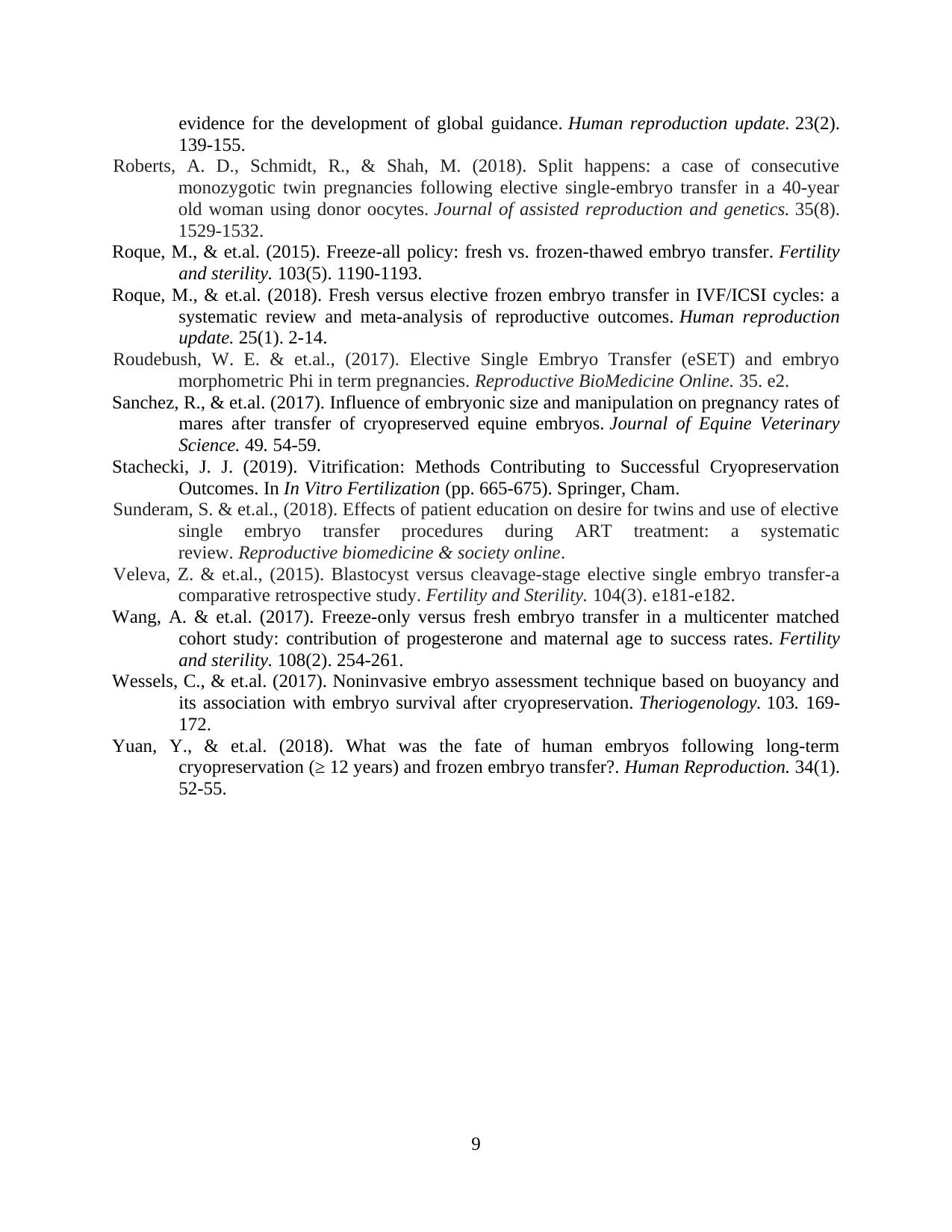
evidence for the development of global guidance. Human reproduction update. 23(2).
139-155.
Roberts, A. D., Schmidt, R., & Shah, M. (2018). Split happens: a case of consecutive
monozygotic twin pregnancies following elective single-embryo transfer in a 40-year
old woman using donor oocytes. Journal of assisted reproduction and genetics. 35(8).
1529-1532.
Roque, M., & et.al. (2015). Freeze-all policy: fresh vs. frozen-thawed embryo transfer. Fertility
and sterility. 103(5). 1190-1193.
Roque, M., & et.al. (2018). Fresh versus elective frozen embryo transfer in IVF/ICSI cycles: a
systematic review and meta-analysis of reproductive outcomes. Human reproduction
update. 25(1). 2-14.
Roudebush, W. E. & et.al., (2017). Elective Single Embryo Transfer (eSET) and embryo
morphometric Phi in term pregnancies. Reproductive BioMedicine Online. 35. e2.
Sanchez, R., & et.al. (2017). Influence of embryonic size and manipulation on pregnancy rates of
mares after transfer of cryopreserved equine embryos. Journal of Equine Veterinary
Science. 49. 54-59.
Stachecki, J. J. (2019). Vitrification: Methods Contributing to Successful Cryopreservation
Outcomes. In In Vitro Fertilization (pp. 665-675). Springer, Cham.
Sunderam, S. & et.al., (2018). Effects of patient education on desire for twins and use of elective
single embryo transfer procedures during ART treatment: a systematic
review. Reproductive biomedicine & society online.
Veleva, Z. & et.al., (2015). Blastocyst versus cleavage-stage elective single embryo transfer-a
comparative retrospective study. Fertility and Sterility. 104(3). e181-e182.
Wang, A. & et.al. (2017). Freeze-only versus fresh embryo transfer in a multicenter matched
cohort study: contribution of progesterone and maternal age to success rates. Fertility
and sterility. 108(2). 254-261.
Wessels, C., & et.al. (2017). Noninvasive embryo assessment technique based on buoyancy and
its association with embryo survival after cryopreservation. Theriogenology. 103. 169-
172.
Yuan, Y., & et.al. (2018). What was the fate of human embryos following long-term
cryopreservation (≥ 12 years) and frozen embryo transfer?. Human Reproduction. 34(1).
52-55.
9
139-155.
Roberts, A. D., Schmidt, R., & Shah, M. (2018). Split happens: a case of consecutive
monozygotic twin pregnancies following elective single-embryo transfer in a 40-year
old woman using donor oocytes. Journal of assisted reproduction and genetics. 35(8).
1529-1532.
Roque, M., & et.al. (2015). Freeze-all policy: fresh vs. frozen-thawed embryo transfer. Fertility
and sterility. 103(5). 1190-1193.
Roque, M., & et.al. (2018). Fresh versus elective frozen embryo transfer in IVF/ICSI cycles: a
systematic review and meta-analysis of reproductive outcomes. Human reproduction
update. 25(1). 2-14.
Roudebush, W. E. & et.al., (2017). Elective Single Embryo Transfer (eSET) and embryo
morphometric Phi in term pregnancies. Reproductive BioMedicine Online. 35. e2.
Sanchez, R., & et.al. (2017). Influence of embryonic size and manipulation on pregnancy rates of
mares after transfer of cryopreserved equine embryos. Journal of Equine Veterinary
Science. 49. 54-59.
Stachecki, J. J. (2019). Vitrification: Methods Contributing to Successful Cryopreservation
Outcomes. In In Vitro Fertilization (pp. 665-675). Springer, Cham.
Sunderam, S. & et.al., (2018). Effects of patient education on desire for twins and use of elective
single embryo transfer procedures during ART treatment: a systematic
review. Reproductive biomedicine & society online.
Veleva, Z. & et.al., (2015). Blastocyst versus cleavage-stage elective single embryo transfer-a
comparative retrospective study. Fertility and Sterility. 104(3). e181-e182.
Wang, A. & et.al. (2017). Freeze-only versus fresh embryo transfer in a multicenter matched
cohort study: contribution of progesterone and maternal age to success rates. Fertility
and sterility. 108(2). 254-261.
Wessels, C., & et.al. (2017). Noninvasive embryo assessment technique based on buoyancy and
its association with embryo survival after cryopreservation. Theriogenology. 103. 169-
172.
Yuan, Y., & et.al. (2018). What was the fate of human embryos following long-term
cryopreservation (≥ 12 years) and frozen embryo transfer?. Human Reproduction. 34(1).
52-55.
9
⊘ This is a preview!⊘
Do you want full access?
Subscribe today to unlock all pages.

Trusted by 1+ million students worldwide
1 out of 12
Related Documents
Your All-in-One AI-Powered Toolkit for Academic Success.
+13062052269
info@desklib.com
Available 24*7 on WhatsApp / Email
![[object Object]](/_next/static/media/star-bottom.7253800d.svg)
Unlock your academic potential
Copyright © 2020–2025 A2Z Services. All Rights Reserved. Developed and managed by ZUCOL.



